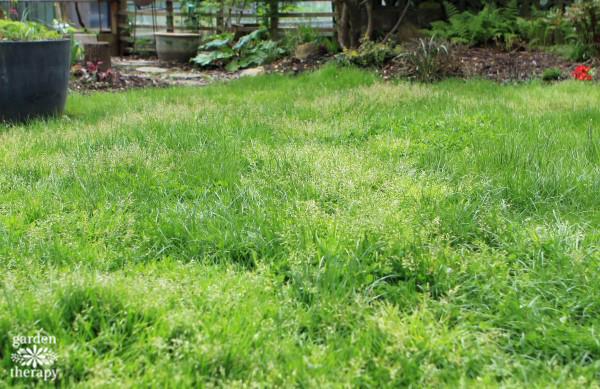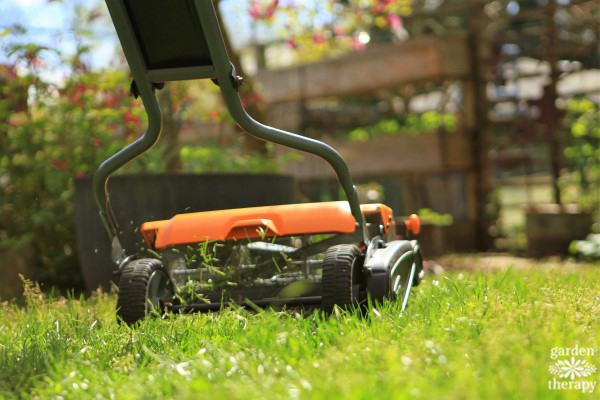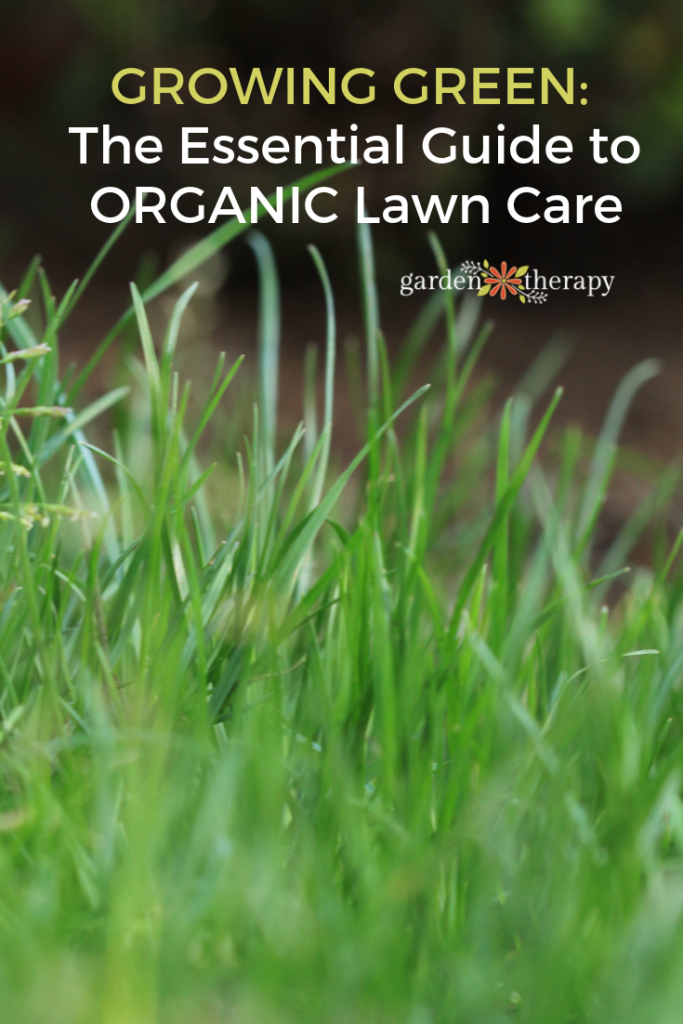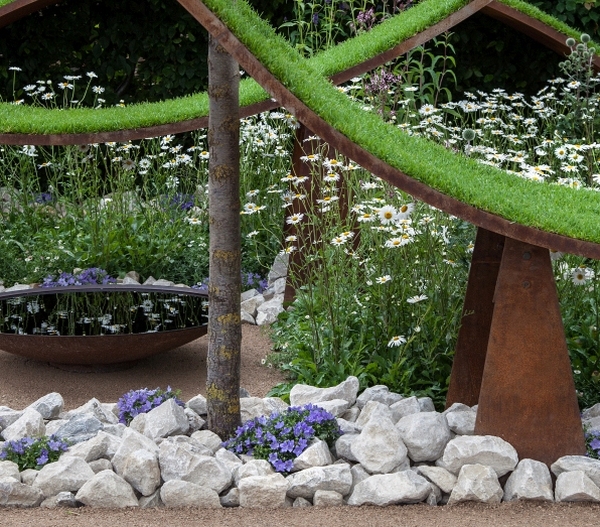Have a giant patch of grass you aren’t sure how to care for? This organic lawn care guide will show you how to care for your yard in the most organic, natural way possible, as well as some grass alternatives to try.

Lawns are evil.
Ok, perhaps that is a harsh generalization. I like a picnic on soft blades of grass as much as the next person. At the same time, I don’t like wasteful practices that are harmful to the earth.
I would much prefer if everyone would replace their water-guzzling lawn with drought-tolerant gardens, native plants to attract pollinators, zero-waste vegetable gardens, or pavers and groundcovers.
I recently transitioned to a no-mow, wildflower lawn in my front yard, and it’s one of my favourite things ever. And the neighbours are equally obsessed with it.
All of the above considered a pristine, green yard is a way of life for many homeowners. Organic lawn care allows you to care for and enjoy your grass in a responsible, nature-friendly way.

5 Steps to Organic Lawn Care
In my old house, I maintained a small patch of grass for kids and pets to play on in the back garden. It was a lovely, green, organic, natural lawn that required almost no maintenance. If you, too, must have grass, then here is how I cared for my lawn without pesticides, herbicides, store-bought fertilizer, or water-waste.

1. Prepare the Soil
Rake the lawn to remove any debris. Remove any weeds without too much digging. Opening up the soil allows dormant weed seeds to awaken and germinate, creating even more weeds! Keep the weeding to a minimum, and it will reduce the overall number of weeds you have to dig up in the future.
2. Check (and Correct) pH
Grass likes alkaline soil. You can easily test your soil’s pH at home with distilled water, vinegar, and baking soda. If necessary, you can also purchase a soil pH test kit.
If you have acidic soil, you can spread some lime to help raise the pH.

3. Overseed
A central part of organic lawn care is overseeding properly. To do so, you’ll need to get the right kind of seed. Lawns are made up of different kinds of grasses—here are just a few:
- Ryegrass is used as a base in lawn mixes. It’s cold-tolerant and rebounds well under heavy traffic. It grows in clumps, so it’s best used in a mix where other grasses can fill in around it.
- Bluegrass is a nice green grass that fills in patches well.
- Tall fescue is an easily established grass that is heat-tolerant.
- Fine fescues are shade-tolerant and slow-growing.
- St. Augustine grass is coarse and dense with wide blades. It thrives in heat and cannot tolerate the cold.
Choose lawn seed that is a mix of these grasses for the best results. A shady lawn blend will work in both sun and shade, so it is a good choice if you have a lawn that has mixed lighting.
Spread seed evenly over the entire lawn, and add some extra in bare patches. Cover seed with a thin layer of turf soil, a mix of compost and sand to ensure good drainage.
For new lawns, seed 3 times in the spring, for instance, March, April, and May. To fill in the lawn, seed 2 times in the spring.
4. Mow and Fertilize
Keep lawn at 2”-3” long to promote vigorous growth and prevent weeds. Fertilize your lawn naturally by leaving grass clippings on the lawn after mowing. They are rich in nitrogen and provide free fertilizer, perfect for turf.
Let the grass grow a bit longer and go to seed before you cut it, and you have now also seeded your lawn in the process!

5. Water
One simple test you can try is to go without watering your lawn for a whole year. Once you do this, you will quickly learn if the lawn is the right choice for your area. If the lawn can’t survive without a lot of added water throughout the season, then think about changing it out.
Some options include ground covers, native species, or even edible gardens (more on this is described at the end of this article).
If you must water your lawn, limit it to 1” of water once a week to promote deep roots that will require less water and maintenance. Measure water by placing a cup or a jar on the lawn and label the cup 1” from the bottom as the fill line.

6. Aerate
If the soil is compacted and needs loosening, you can pierce the sod with a pitchfork in the fall, then spread turf soil and rake to fill it in. This doesn’t need to be done every year. Every 3-4 years or as needed is sufficient.
Keep in mind that any aeration also invites dormant weed seeds to become active again, so aeration should only be used when soil is clearly too compacted to thrive.

With these steps for organic lawn care, I maintain a small and lush patch of grass in my yard. It is surrounded by flowering and edible gardens. One day, it may be removed forever. For now, though, I have a lovely organic lawn.
Grass Alternatives to Try
If your grass can’t easily be managed in your yard using these tips, then it might be time to consider replacing your lawn. Here are some alternative ground covers to try:
- Moss
- Blue Star Creeper (Isotoma fluviatillis)
- Kidney Weed (Dichondra micrantha)
- Bugleflower (Ajuga reptans)
- White clover (Trifolium repens)
- Periwinkle (Vinca minor)
- Elfin Thyme (Thymus serpyllum).
Additionally, many seed companies also create an eco-lawn alternative full of hardy plant mixes that are perfect for lawn replacement as they require less mowing and water, and can survive foot traffic.
I will shout from all rooftops about my wildflower lawn. It’s one of the most eye-catching and low-maintenance lawn alternatives. I didn’t mow it or water it ONCE the entire year I had it. And every single person who walks by can’t help but admire all the flowers.
Or why not turn your lawn into garden? Here are some tips on converting lawn into garden beds without waste.
Oh, and if you are looking for a way to prevent dogs from destroying the grass by doing their ‘business,’ then check out this article on building a flushable dog run.
Organic Lawn Care FAQ
It is completely natural and healthy for grass to turn brown in the heat of summer. Grasses do not like heat and will go dormant in very hot weather to protect the plants. The best way to deal with this is to accept that lawns will brown in the summer and turn green again when the temperature cools. Save water and allow the plants to thrive by supporting their natural cycle, not preventing it.
Compost is pure garden gold. It helps to build up nutrients, increase water retention, and improve soil structure. I add it to all parts of my garden, from beds and containers to my alternative lawn. You can make it yourself using kitchen and garden scraps or buy it inexpensively from your city or a local garden centre. There are plenty of other soil amendments you can consider adding, listed here.
More Lawn Care Tips



